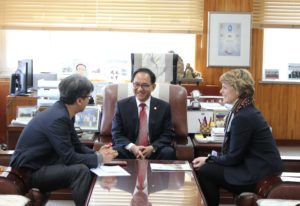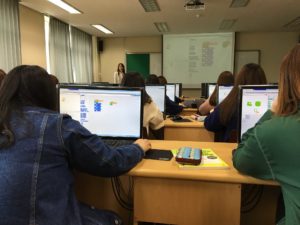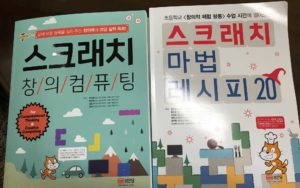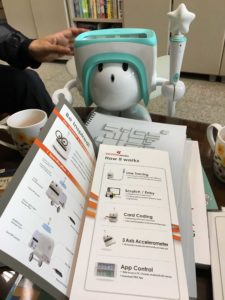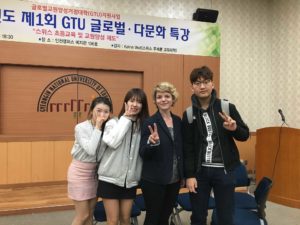South Korea is well known for its technological upswing. Korean brands like LG and Samsung are present all around us in form of smartphones and other devices.
But how does technology effect education in schools and in teacher education in a country that seems to be embracing technology so well?
A visit at the Gyongin National University of Teacher Education gave me a wonderful insight into the topics, strategies and issues our partner University in South Korea is faced with and also a great new perspective on our own projects and work.
It is cherry blossom season and the Gyongin Campus in Incheon is full of blooming trees when I arrive.
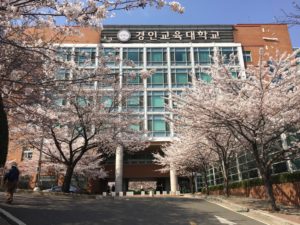
The first meeting with the international office is a warm welcome and great start to the following three day program.
An official meeting with the president of the university is of course very exciting and the protocol is quite formal compared to what we are used to in Switzerland. Tea is served, business cards and gifts are exchanged and photos are taken for our memories and websites.
A series of meetings with different professors of the university as well as a student gives me an insight into the day to day life on campus. There are two campuses, one in Incheon and one in Gyeonggi-do. I can stay on campus in Incheon, which makes the stay very easy and comfortable. Everything is in a walkable distance from here. Everything else, like the visit to the remote campus, is organized by the international office team. I am so well taken care of during my stay.
During the different meetings, I learn about the changes in governmental policies. „Smart learning“ was an initiative by the Korean government but with the change of the government, many policies changed as well and the initiative was put on hold. New policies are being implemented and the curriculum is being changed toward a competency based framework. Digital media do play a role in the new curriculum. Mainly in the form of programming and computational thinking as subjects for students on different levels, as well as digital textbooks that will be implemented over time.
Coding is one of the subjects that is now being introduced in several schools on all levels of education. I am able to attend one of the lessons at Gyongin University.
The students are given several tasks within the „Scratch“ programming environment. An open source programming language, developed by the MIT. The students solve most of the tasks with ease. One activity makes them develop the code together. The rule is not to change the previous code of the partner but to work with possible mistakes and to find solutions or detours if necessary. Soon enough, cats are rotating across screens, leaving colorful traces.
I meet with Professor Han, of the department of Computer Education. We speak about the importance of computational thinking for the curriculum and how it is not „just“ programming. That a diverse set of skills is required to solve problems and create solutions. Professor Han is strongly committed to his work and shows the Scratch textbooks to me that he has translated into Korean as well as the brochure for the robot that his team is developing.
I notice that many textbooks look very playful and comic-like, even for adult learners.
I then get the chance to visit the Haeseo Elementary School next doors. Many students of Gyongin University do their internships here but it is not the only school that supports the teacher education.
The kids are quite excited to see a foreign guest but quickly attend to the teacher and the screen in the front. All classrooms are fitted with a screen as well as a projector.
The teacher uses several videos for the kids to sing or speak along as well as her smartphone to show group works of the students on the screen in the front.

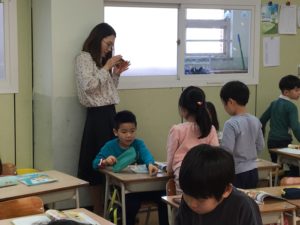

Later she explains that she also documents some of the work for a platform that the parents have access to so that they can see what has been done in class.
I ask her about using digital media in the classroom and how she learned to use them in different settings.
She tells me that it was not part of her university education and that teachers tend to teach each other on the usage of media in the classroom. She uses a platform where teachers exchange ideas, concepts and tips on their work in the classroom. I am very impressed with all the colors, material and equipment in the elementary school. The afternoon passes by very quickly.
I am excited. Now it is up to me to be in front and give a presentation on the education system in Switzerland. There are many differences to the system in Korea. One of the main differences is that most Koreans attend a university for their education as there is no dual education system like the apprenticeship in Switzerland. It is very tough to get into a good university and not everybody has the freedom of choice in terms of the subject they want to study. A good income and secure job situation is the main focus when preparing for the entry exams. Kids at a very young age start preparing for this exam by studying many hours, even late at night. The students are very impressed with the options that the Swiss education system offers. Especially with the many different paths one can take. Despite the warning that probably not many questions will be asked, the students are not shy to speak in English and ask many questions.
The days pass so quickly and soon I am on my way to the next destination, the Hyugo University of Teacher Education in Kato, Japan.
I leave with many colorful impressions and a different view on our own work back in Switzerland. An exchange visit is such a powerful thing to do. I can only recommend it.
Thank you so much to our partner institution in Incheon, Gyeongin National University of Teacher Education and the team at the International Office in Switzerland who made this visit possible.

